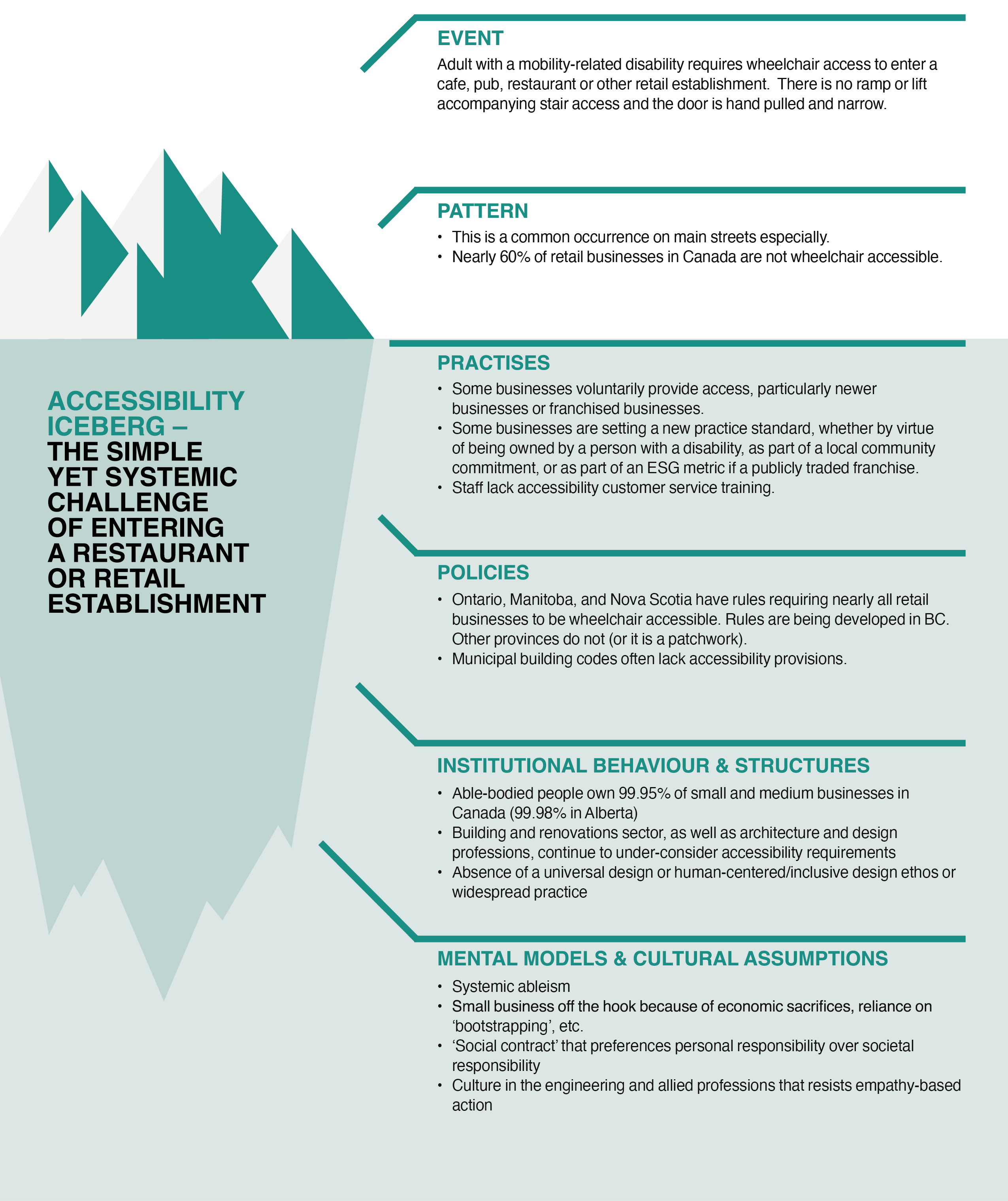Domain 2: Accessible Building and Urban Design
37 Systems Snapshot – Accessibility Iceberg: Entering a Restaurant or Retail Establishment
A helpful tool for understanding systems is the Iceberg Model,[1] and one aspect of accessibility, entering a restaurant or retail establishment, can be mapped using this tool. The Iceberg Model challenges us to dive into the layers of a systemic issue, starting with the Events and Patterns above the surface and moving downward through practices, policies, structures, and eventually identifying the mental models and cultural assumptions that influence what we experience on the higher levels.
The graphic below, Accessibility Iceberg: The Simple yet Systemic Challenge of Entering a Restaurant or Retail Establishment, begins with the Event of an adult with a mobility-related disability who requires wheelchair access to enter a cafe, pub, restaurant or other retail establishment but there is no ramp or lift accompanying stair access and the door is hand-pulled and narrow. Continue past the image for a full text description of the graphic.

Event:
Above the surface of the Iceberg, an individual who uses a wheelchair is not able to enter a restaurant or business because there is no ramp and the door requires
Pattern:
This event is a common occurrence, especially on main streets, so this Pattern of experiences is represented at the surface of the water. Nearly 60 percent of businesses in Canada are not wheelchair accessible.
Practices:
As we start to dive into the water below the Iceberg, common Practices that cause the Events and Patterns are identified. Some businesses voluntarily provide access, particularly newer businesses or franchised businesses, which means access can be dependent on individual establishments. Some businesses are setting a new practice standard, whether by virtue of being owned by a person with a disability, as part of a local community commitment, or as part of an ESG metric if a publicly traded franchise. We also note the common practice of staff lacking accessibility customer service training.
Policies:
Policies have a significant influence on Practices, especially business practice. Ontario, Manitoba, and Nova Scotia have rules requiring nearly retail businesses to be wheelchair accessible, and rules are being developed in BC. Other provinces do not have policies (or it is a patchwork), which increase the likelihood of customers experiencing these barriers. Additionally, Municipal building codes often lack accessibility provisions.
Structures:
Some of the Structures which amplify these patterns are that able-bodied people own 99.95% of small and medium businesses in Canada (99.98% in Alberta), and those who do not currently experience a disability are less likely to adopt accessible standards. The building and revovations sector, as well as architecture and design professions, also continue to under-consider accessibility requirements. There is overall an absence of a universal design or human-centered/inclusive design ethos or widespread practice
Mental Models and Cultural Assumptions:
The Mental Models and Cultural Assumptions that shape our thinking, policies, structures, and ways of being all lie at the bottom of the Iceberg. They are the most difficult to get to and the most difficult to change. These include Systemic ableism, the belief that small business are off the hook because of economic sacrifices over reliance on ‘bootstrapping’, the ‘Social contract’ that preferences personal responsibility over societal responsibility for implementing changes, and the culture in the engineering and allied professions that resists empathy-based action.
- University of Oxford and Saïd Business School. (2022). Systems Thinking Technique 1: The Iceberg Model. [pdf] https://static1.squarespace.com/static/5f2342b2a374436dd8ee5dac/t/6206bcff795a8673e82b0346/1644608769642/Summary_Iceberg+Model_Grameen+Bank.pdf ↵
